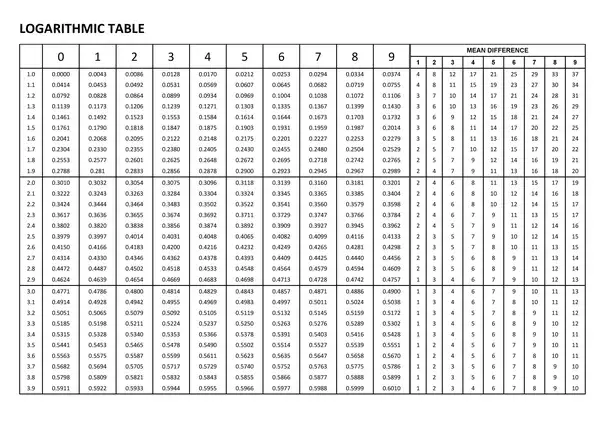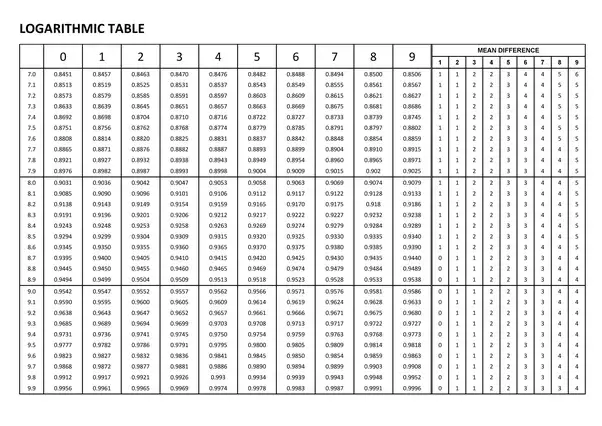Quantitative Aptitude :: Logarithm
Home > Quantitative Aptitude > Logarithm > Important Formulas
Accenture (150)
Adobe (4)
Alcatel-Lucent (2)
Broadcom Ltd (33)
Aricent (7)
Amazon (9)
Wipro (378)
Tech Mahindra (432)
IBM (455)
BOA (Bank of America) (70)
Capgemini (489)
Commvault (40)
Nagarro (80)
TCS (677)
Infosys (297)
Cognizant (128)
Mu-Sigma (25)
HCL Technologies (112)
Virtusa (121)
CGI (50)
Syntel Inc. (91)
ThoughtWorks (33)
iGate (356)
Cisco (127)
Global Edge (166)
Green Valley Motor (76)
Sopra Steria (83)
Societe Generale (224)
L&T Infotech (17)
MindTree (60)
SAP Labs (27)
Hexaware Technologies (60)
TCS NQT (612)
TCS Digital (95)
TCS Ninja (80)
Huawei (50)
Wipro NLTH (175)
Reliance Jio (26)
Radisys (2)
GlobalLogic (2)
Brocade (2)
Sapient (1)
(2)
Acuvate Software (1)
Citrix (2)
Goldman Sachs (1)
Happiest Minds (1)
Deloitte (2)
Logarithm Important Formulas
A logarithm is the inverse of the exponential function. Specifically, a logarithm is the power to which a number (the base) must be raised to produce a given number.
Example, we know that 2 raised to the 5th power equals 32. This also can be expressed by the exponential equation 25=32.
The above exponential equation (i.e 25=32) can be expressed by the logarithmic equation \(\log_{2} 32\)=5, read as "log base two of sixteen is four".
How \(2^{5}\) = 32 \(\iff\) \(\log_{2} 32\)=5.
Lets understand by below example:
\(2^{5}\) = 32
Take log both side.
\(\log 2^{5}\) = \(\log 32\)
By below log formula:
i.e \(\log a^{x}\) = \(x \log a\)
so, \(5 \log 2\) = \(\log 32\)
=> \(\frac{\log 32}{\log 2}\) = 5
=> \(\log_{2} 32\)=5 Hint: \(\frac{\log a}{\log b}\) = \(\log_{b} a\)
Logarithm:
If a is a positive real number, other than 1 and \(a^{m}\) = x, then we write:
m = \(\log_{a} x\) and we say that the value of log x to the base a is m.
Examples:
(i). \(10^{3}\) = 1000 \(\iff\) \(\log_{10} 1000\) = 3
(ii). \(2^{-3}\) = \(\frac{1}{8}\) \(\iff\) \(\log_{2} \frac{1}{8}\) = -3
(iii). \(\left(.1\right)^{-3}\) = .01 \(\iff\) \(\log_{.1} .01\) = 2
2. Properties of Logarithms:
(i). \(\log_{a} (xy)\) = \(\log_{a} x\) + \(\log_{a} y\)
(ii). \(\log_{a} \left(\frac{x}{y}\right)\) = \(\log_{a} x\) - \(\log_{a} y\)
(iii). \(\log_{x} (x)\) = 1
(iv). \(\log_{x} (1)\) = 1
(v). \(\log_{a} \left(x^{n} \right)\) = n \(\left(\log_{a} x \right)\)
(vi). \(\log_{a} x\) = \(\frac{1}{\log_{x} a}\)
(vii). \(\log_{a} x\) = \(\frac{\log_{b} x}{\log_{b} a}\) = \(\frac{\log x}{\log a}\)
3. Common Logarithms:
Logarithms to the base 10 are known as common logarithms.
The logarithm of a number contains two parts, namely 'characteristic' and 'mantissa'.
Characteristic:
The internal part of the logarithm of a number is called its characteristic.
Case I: When the number is greater than 1.
In this case, the characteristic is one less than the number of digits in the left of the decimal point in the given number.
Case II: When the number is less than 1.
In this case, the characteristic is one more than the number of zeros between the decimal point and the first significant digit of the number and it is negative.
Logarithms TABLE:



How to user logarithms table: Click Here
